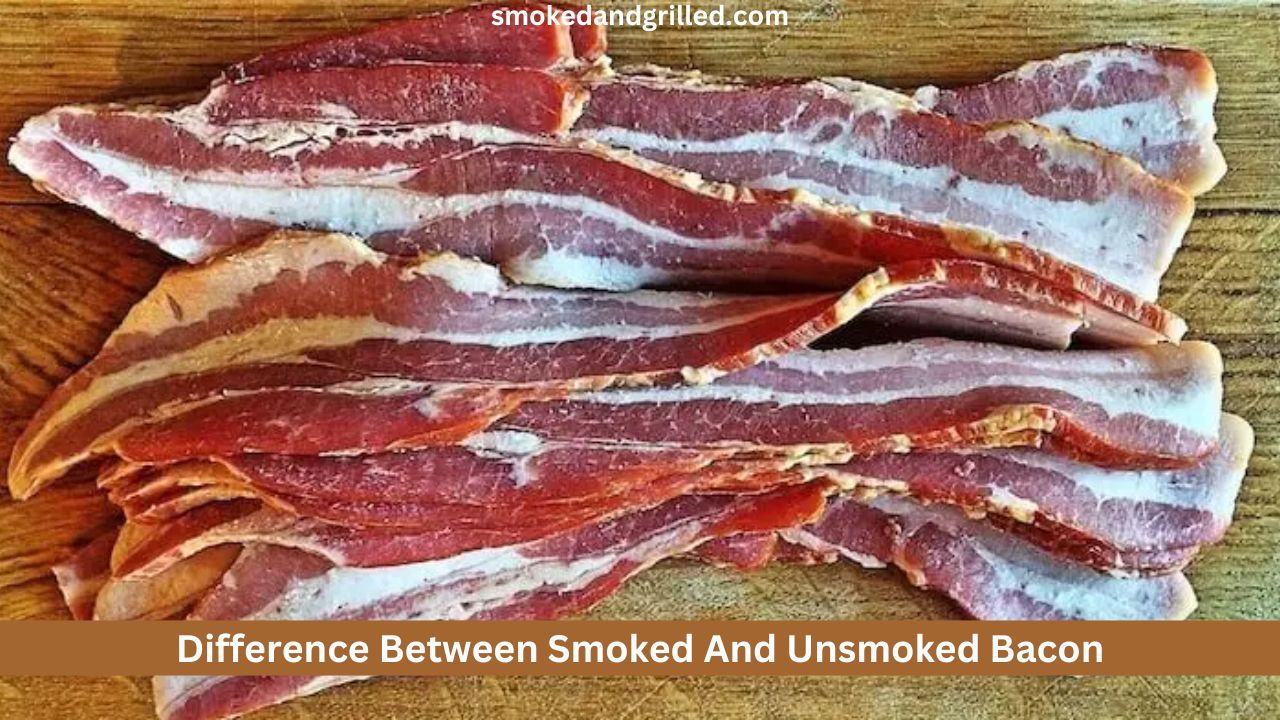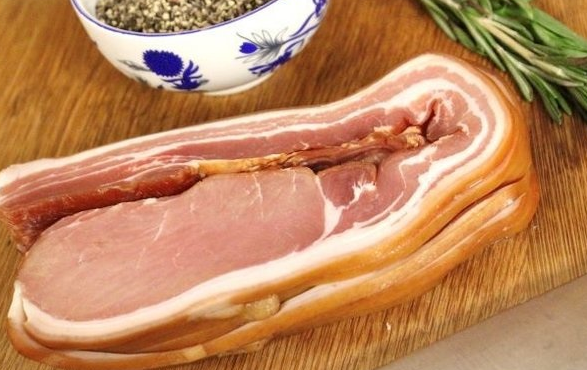If you love Bacon, you’ve probably heard of smoked and unsmoked varieties.
But what is the distinction between these two varieties, and how does it alter their flavor?
Additionally, the preparation of smoked Bacon and unsmoked Bacon is different from one another.
The term “unsmoked bacon” refers to meat that has just been cured with salt, in contrast to “smoked bacon,” which is prepared by smoking the meat.
In this blog post, we will explore the differences between smoked and unsmoked Bacon to help you decide which one you should choose for your next delicious meal!
What Is Smoked Bacon?
Smoked Bacon is delicious pork bacon that has been cooked and flavored by smoking the meat over a fire.
This process of curing, typically done in either a smoker or a smokehouse, exposes the Bacon to low temperatures and smoldering wood chips for prolonged periods of time.
Depending on the flavor profile desired, different types of wood may be used in the smoking process.
The resulting flavor from Smoked Bacon is deeply savory and smoky with subtle sweet notes, offering something truly unique for any dish or occasion.
What Is UnSmoked Bacon?
Unsmoked Bacon, also sometimes referred to as green Bacon, is a product made from the same raw ingredients used in traditional smoked Bacon.
The difference lies in the lack of smoking.
Unsmoked Bacon instead relies on curing techniques such as brining, where it is soaked in a saltwater solution, or dry curing, where the pork belly is rubbed with a mixture of salt and other spices to give it its distinct flavor and texture.
Like regular Bacon, this one provides an excellent source of protein and essential fatty acids that make it a healthy addition to any meal.
All you need to do is cook some unsmoked bacon slices in your skillet, and you’ll have an easy-to-make breakfast item with plenty of health benefits.
Smoked Vs. Unsmoked Bacon
There are distinctions between smoked Bacon and unsmoked Bacon.
1- Cooking Process
Smoke is used to impart flavor, brown, cook, and preserve smoked Bacon by using smoldering or burning materials as the source of the smoke.
Unsmoked Bacon, on the other hand, is a type of Bacon that is salted during the curing process but is not subjected to smoke treatment.
Despite the fact that many people favor the straightforward flavor of unsmoked Bacon, this type of meat product is frequently confused with a thin slice of ham rather than Bacon.
2- Taste
When it comes to taste, smoked Bacon has a more intense profile than its unsmoked counterpart.
The equipment that is used to smoke the meat and the length of time that it is smoked both have an effect on the flavor.
The flavor of smoked Bacon is typically described as having notes of nuttiness, sweetness, grassiness, and butter.
It is because of this factor that a significant number of people favor it more than unsmoked Bacon.
When properly prepared, smoked Bacon retains an exceptional amount of both its juiciness and its tenderness.
3- Tenderness
Because smoked Bacon is typically more firm than unsmoked Bacon, this makes it ideal for foods like egg salads and sandwiches in which a bit of crunch is desired; unsmoked Bacon is typically more commonly used.
4- Color
Unsmoked Bacon has a pinkish hue, whereas smoked Bacon appears more reddish-brown.
This difference in coloration happens due to the curing process; unsmoked Bacon is cured using saltwater brine, while smoked Bacon undergoes an additional smoking process.
The glowing embers of traditional hardwood such as hickory or mesquite give the smoky flavor we all love and results in the darker coloration.
5- Texture
Smoked Bacon has a firmer texture because it’s been cured with salt and exposed to smoke which helps draw out more moisture, resulting in a crispier cooked product.
By comparison, the texture of unsmoked Bacon is softer because it has not been through the curing/smoking process – moisture stays within the meat during cooking, making it slightly chewier than its smoked counterpart.
Both types of Bacon can make for a delicious morning meal, but each provides its own unique taste sensation.
Which Bacon Is More Salty Smoked Or Unsmoked?
As widespread perception would have it, unsmoked Bacon often has less salt than its smoked counterpart.
In addition, the salt content of various kinds of Bacon does not follow any kind of established pattern.
This is why accurate and transparent labeling of bacon products is so important.
The smokiness of Bacon doesn’t diminish its saltiness. Instead, it merely improves the meat’s flavor, dries it out, and helps it keep for longer.
The salt used in the curing process is responsible for the salty flavor of both smoked and unsmoked Bacon.
It aids in food preservation by removing moisture from the meat, making conditions less favorable for spoilage organisms like bacteria and mold.
This is why burning food can help prolong its storage life.
Meat is preserved in a variety of ways across cultures.
Many also use it to preserve food, as they think that salt contains contaminants that can have unintended consequences when curing.
Since salt is the primary ingredient in curing, unsmoked Bacon is more likely to taste salty than smoked varieties.
Also Read: Smoker Turning Food Black (What’s Going On)
Different Cuts Of Smoked And Unsmoked Bacon
Bacon comes in a variety of cuts based on the preferences of local consumers, whether smoked or unsmoked.
Here are the several varieties of bacon cuts:
Back Bacon
It gets its name because the cut comes from the back, not the belly, which is where regular Bacon comes from.
Back Bacon can be eaten raw or cooked by grilling, baking, or frying.
Often it is rolled in seasoned bread crumbs before cooking for extra flavor and texture.
This type of Bacon is called Canadian Bacon and adds an interesting flavor twist to classic dishes such as eggs benedict.
Streaky Or Side Bacon
Streaky or side Bacon is a cut of pork belly that is cured, smoked, and sliced into thin strips.
This type of Bacon is known by many different names (streaky, streaky, slab, rasher, fatback) depending on the region where it is produced.
It has a unique flavor due to its higher fat content than other cuts of Bacon and tends to have a longer shelf life due to its curing process with salt and spices over time.
Streaky or side Bacon can be used in various dishes for an interesting kick that won’t go unnoticed!
Jowl Bacon
Jowl Bacon is a classic cut of pork bacon, popular in many parts of the world.
It is among the oldest and most traditional types of processed pork, dating back to thousands of years ago in Europe.
Its distinct flavor makes it a popular choice for making bacon bits and other delicious dishes, but it also can be eaten on its own as a delicious snack.
With its unique taste and texture, Jowl Bacon definitely adds something special to any culinary experience.
Collar Bacon
Collar bacon is a surprisingly versatile cut of meat that comes from the back, extending up to the neck area near the shoulder blade of a pig.
This cut has an optimal fat-to-meat ratio and is full of tender, juicy flavor.
Often referred to as square-cut Bacon or Beeler’s Bacon, Collar Bacon can be used in a variety of dishes aside from traditional bacon breakfast strips.
Cottage Bacon
Cottage bacon is a type of pork cut that comes from the boneless pork shoulder, which is located just above the upper part of the pig’s legs.
It has more flavor than traditional Bacon and is usually much thicker due to having fat added between alternating layers of lean and fat cuts.
Typically, it is cured with salt, brown sugar, and other spices, such as cloves and cayenne pepper, before being fully cooked.
However, it can also be enjoyed uncured, depending on the desired flavor, texture, and health concerns.
Cottage bacon is most often found sliced into thin strips for cooking or served in slices as part of a breakfast plate.
Prosciutto
Prosciutto is an Italian type of ham that is made from pork leg.
It is dry-cured with salt and spices, then aged for several months.
Prosciutto has a deep, rich flavor and is often served as an appetizer with bread or used as an ingredient in pasta dishes or salads.
Guanciale
Guanciale is an Italian type of Bacon that is made from pork cheek.
Lardo
Lardo is an Italian type of fatback that is made from pork fatback.
It is cured with salt and spices, then aged for several months.
Lardo has a deep, rich flavor and is suitable for use in pasta dishes or sauces or spread on bread as an appetizer.
Is It Safe To Eat Undercooked Smoked Or Unsmoked Bacon?
For those who love Bacon, eating it undercooked may seem like a delicious temptation.
But if you’re thinking of indulging in a partially cooked piece of smoked or unsmoked Bacon, think again – it’s not safe for consumption!
If done correctly, your Bacon will be crispy around the edges and still retain some moisture in the middle.
Eating undercooked Bacon can lead to numerous foodborne illnesses, so always ensure to cook Bacon thoroughly.
If you plan on consuming partially cooked Bacon – such as if you are adding it to a dish that will continue cooking – then make sure to buy the highest quality possible so you can avoid any unnecessary health risks.
Smoked Or Unsmoked Bacon For Breakfast
If you want to take start with a delicious and nutritious meal, consider smoked or unsmoked Bacon for breakfast!
Smoked Bacon is especially popular for its smoky flavor, which also makes it ideal for sandwiches, tacos, and salads.
Versatile and quickly cooked on the stove or in the oven or microwave, Bacon is a great way to get protein at the start of your day.
Plus, with different types of pork and turkey bacon available, there’s even something available, no matter what dietary preference you have. So give smoked or unsmoked Bacon a try – you won’t regret it!
Smoked Or Unsmoked Bacon Healthier
When it comes to deciding between smoked or unsmoked Bacon, the health benefits can vary considerably.
On the one hand, smoked Bacon is often higher in nitrates, which can help preserve and add flavor but are also associated with an increased risk of developing certain types of cancer.
On the other hand, unsmoked Bacon typically has a less desirable taste and may have a shorter shelf life than its smoked counterpart.
Regardless of the form you choose, generally speaking, either kind of Bacon should be consumed sparingly.
Eating excessive amounts of any type of processed meat can have negative implications for your overall health, so proper management is key when enjoying Bacon!
Similarities Between Smoked And Unsmoked Bacon
Bacon is a versatile breakfast favorite, and its smoky flavor is pleasing to many.
While smoked Bacon is considered the mainstream variety, there are still plenty of similarities between smoked and unsmoked Bacon when it comes to taste and nutrition.
Both types of Bacon contain close to the same amount of calories, saturated fat, and sodium per 3-ounce serving.
Additionally, both types feature the same savory salty flavor due to their high concentration of nitrites and nitrates.
The cuts of meat are where the smoked and unsmoked varieties of Bacon are most comparable to one another.
Both products are made of pig, and the cuts are comparable to one another in most respects, including the back cut, the center cut, the side bacon made from hog belly, and the slab bacon.
The cut of Bacon that is most prevalent in Japan is called a shoulder cut, which is much different from the appearance of Canadian Bacon, which is more similar to a slab of ham.
Smoked Or Unsmoked Bacon In My Sandwich?
When it comes to creating a sandwich, there are a few choices one must make in order to get the perfect flavor and texture.
For instance, should you choose smoked or unsmoked Bacon? A lot depends on your personal preference here; both types of Bacon have their benefits and drawbacks.
However, it can also be quite salty and have a chewy texture when cooked. On the other hand, unsmoked Bacon is milder in taste and can often provide a more tender texture.
When making your sandwich, it’s important to consider which type of Bacon would pair better with your other ingredients.
Experimenting is key – use either smoked or unsmoked Bacon for different sandwiches, but be sure to find the perfect combination for your most enjoyable meal.
How Can You Tell If Bacon Is Smoked?
There are a few ways to tell if Bacon is smoked. First, look at the color of Bacon. Smoked Bacon will typically be darker in color than unsmoked Bacon.
Finally, taste the Bacon. Smoked Bacon will have a smoky flavor, while unsmoked Bacon will not.
How Can You Tell If Bacon Is Unsmoked?
There are a few ways to tell if Bacon is unsmoked. First, look at the color of Bacon.
Unsmoked Bacon will typically be lighter in color than smoked Bacon Second, smell the Bacon.
Unsmoked Bacon will not have a smoky aroma, while smoked Bacon will. Third, taste the Bacon.
Unsmoked Bacon will not have a smoky flavor, while smoked Bacon will.
Is Smoked Or Unsmoked Bacon Better?
This depends on personal preference. Some people prefer the flavor of smoked Bacon, while others prefer the flavor of unsmoked Bacon.
There is no right or wrong answer here – it all comes down to what you personally prefer.
Conclusion
To provide a brief overview, smoked Bacon and unsmoked Bacon are two distinct forms of Bacon, both of which can be purchased in a variety of slices.
You can get unsmoked or smoked cottage bacon, collar bacon, jowl bacon, streaky or side Bacon, Back Bacon, and a variety of other distinctive cuts of Bacon that are common in other countries.
Additionally, nations all around the world have distinctly contrasting tastes when it comes to Bacon.
Choose the smoked variety of Bacon if you’re looking for something with a more robust flavor.
If you want to enjoy the flavor of cured hog meat as it was originally prepared, choose the option that does not include smoking.
Also Read: Pellet Grill vs Pellet Smoker: A Complete Comparison



